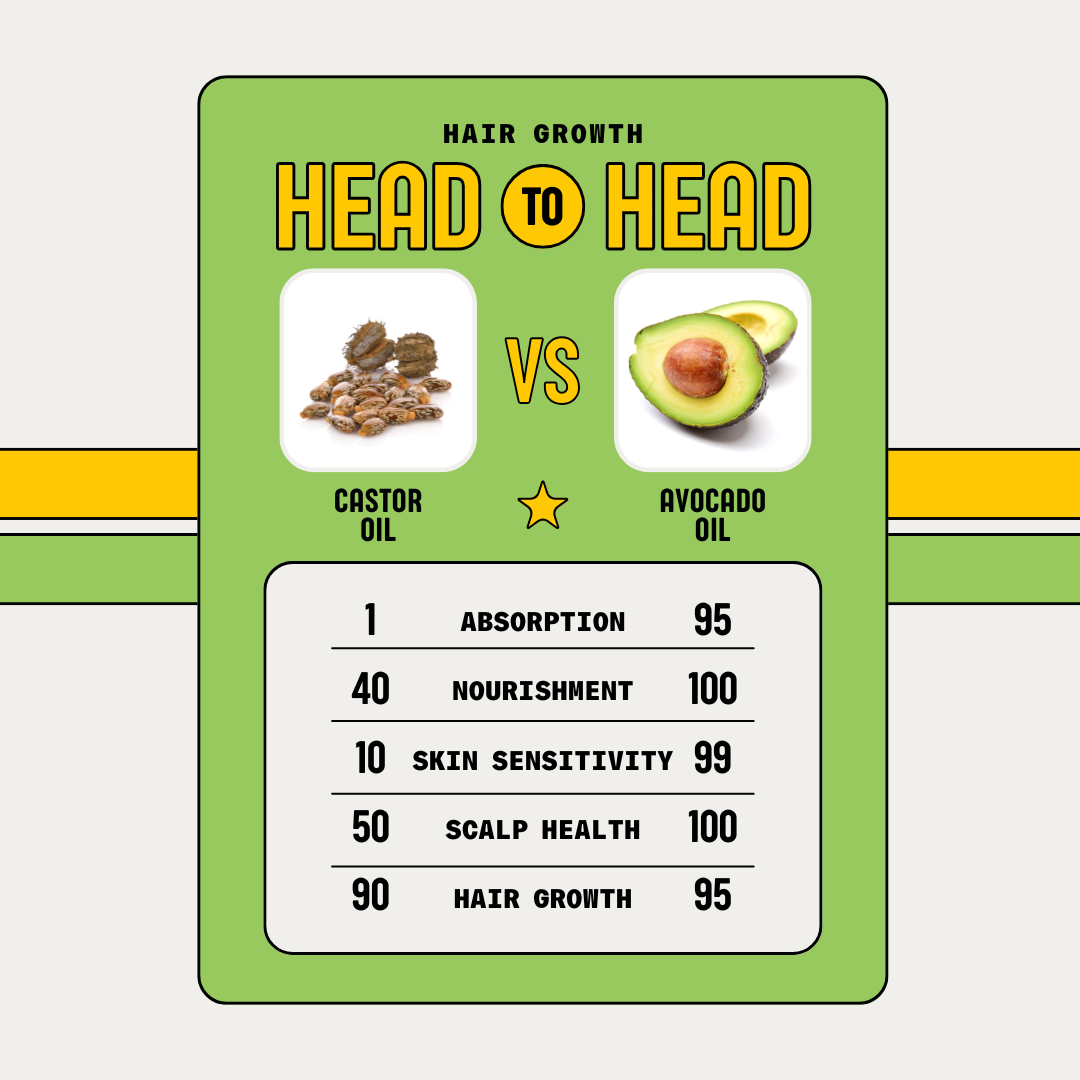
Why We Chose Organic Avocado Oil Over Castor Oil for Our Organic Scalp Oil: A Science-Backed Deep Dive
Share
When formulating our Organic Scalp Oil, we faced a critical decision: which carrier oil would best nourish the scalp, promote healthy hair growth, and suit a wide range of users, including those with sensitive skin or babies?
After careful consideration and a thorough review of scientific evidence, we opted for organic avocado oil over the widely popular castor oil. This blog explores the reasons behind our choice, delving into the nutritional profiles, physical properties, and dermatological benefits of these oils, supported by peer-reviewed studies and expert insights.
The Nutritional Powerhouse: Avocado Oil’s Composition
Organic avocado oil, derived from the pulp of Persea americana, is a nutrient-dense oil celebrated for its rich content of essential fatty acids, vitamins, and antioxidants. Studies highlight its high levels of monounsaturated fats, particularly oleic acid (approximately 70%), which contribute to its emollient properties (Dreher & Davenport, 2013). Oleic acid is known to enhance skin barrier function by improving moisture retention and reducing transepidermal water loss—a key factor in soothing dry, irritated scalps (Lin et al., 2017).
Beyond fatty acids, avocado oil is packed with vitamins A, D, and E—each playing a unique role in scalp and hair health:
- Vitamin A supports cell turnover and repair, promoting a healthy scalp environment (Everett et al., 2019).
- Vitamin D has been linked to hair follicle cycling and growth, with deficiencies associated with hair loss conditions like alopecia (Rasheed et al., 2013).
- Vitamin E, a potent antioxidant, protects scalp cells from oxidative stress caused by environmental factors like UV radiation and pollution (Keen & Hassan, 2016).
Additionally, avocado oil contains phytosterols and polyphenols, which exhibit anti-inflammatory properties. A 2015 study published in Evidence-Based Complementary and Alternative Medicine demonstrated that avocado oil reduces inflammation in skin models, making it an excellent choice for calming scalp irritation (Nayak et al., 2015).
Penetration Power: Why Avocado Oil Outshines Castor Oil
One of the standout features of avocado oil is its ability to penetrate the skin and hair shaft effectively. Research shows that oils with higher levels of monounsaturated fatty acids, like avocado oil, have a lower molecular weight and better skin permeability compared to oils dominated by polyunsaturated or saturated fats (Vaughn et al., 2018). This penetration allows avocado oil to deliver its nutrients deep into the scalp, hydrating the skin and supporting the hair follicles at their root.
In contrast, castor oil—extracted from the seeds of Ricinus communis—is predominantly composed of ricinoleic acid (about 90%), a hydroxy fatty acid with a thicker, more viscous consistency (Patel et al., 2016). While ricinoleic acid has anti-inflammatory and antimicrobial properties, its larger molecular structure limits its ability to penetrate deeply. A study in the Journal of Cosmetic Science found that castor oil tends to sit on the surface of the skin and hair, creating a barrier rather than nourishing from within (McMullen & Jachowicz, 2003). For a scalp oil designed to hydrate and support growth, this surface-level action was a significant drawback.
Texture and User Experience: Avoiding the Sticky Trap
Castor oil’s thick, sticky texture is one of its most recognisable traits—and one of its biggest limitations. Its high viscosity (approximately 950 centipoise at room temperature) makes it challenging to apply evenly and wash out, often leaving a greasy residue (Mutlu & Meier, 2010). For a product intended for daily or frequent use, this was a non-starter. Our goal was a lightweight, non-greasy formula that feels luxurious and absorbs quickly—qualities avocado oil delivers effortlessly.
Avocado oil, with a viscosity of around 60-80 centipoise, strikes a perfect balance: it’s nourishing without weighing down the hair or scalp (Dreher & Davenport, 2013). This lighter texture enhances user comfort, especially for those with fine hair or sensitive skin prone to feeling overwhelmed by heavier oils.
Safety First: Hypoallergenic and Gentle for All
When crafting a scalp oil suitable for everyone—including babies and individuals with sensitive skin—safety and tolerability were paramount. Avocado oil’s hypoallergenic nature made it the clear winner. A 2017 study in Contact Dermatitis found that avocado oil has a low incidence of allergic reactions, even among those with compromised skin barriers (de Groot & Schmidt, 2017). Its gentle profile is attributed to its similarity to human sebum, which reduces the likelihood of irritation or sensitisation.
Castor oil, while beneficial for some, carries a higher risk of adverse reactions. Ricinoleic acid, though therapeutic, can be irritating to sensitive skin in high concentrations. A clinical review in Dermatitis reported cases of contact dermatitis linked to castor oil, particularly in individuals with pre-existing sensitivities (Zug et al., 2014). Additionally, its thickness can clog pores or exacerbate conditions like seborrheic dermatitis in susceptible users, a concern we wanted to avoid entirely (Borda & Wikramanayake, 2015).
For babies, whose skin is thinner and more permeable, the choice was even clearer. Paediatric dermatology guidelines emphasise the use of mild, non-irritating oils with proven safety profiles, and avocado oil fits this criterion perfectly (Blume-Peytavi et al., 2016).
Supporting Healthy Hair Growth: The Evidence
Both avocado and castor oils are touted for their hair growth benefits, but the mechanisms differ. Castor oil’s reputation stems largely from anecdotal evidence and its ricinoleic acid content, which may stimulate prostaglandin pathways linked to hair growth (Semalty et al., 2011). However, clinical studies validating these claims are sparse, and its efficacy remains inconclusive.
Avocado oil, on the other hand, supports hair growth through a well-documented synergy of nutrients. Vitamin E and fatty acids strengthen hair strands and reduce breakage, while vitamin D supports follicle health (Trüeb, 2015). A 2020 study in the International Journal of Trichology found that topical application of oils rich in monounsaturated fats and antioxidants, like avocado oil, improved hair shaft integrity and reduced scalp inflammation—key factors in maintaining a healthy growth cycle (Draelos, 2020).
Our Commitment to a Universal Formula
Our Organic Scalp Oil was designed with inclusivity in mind. We wanted a product that nourishes deeply, soothes effectively, and feels comfortable for all users—without the risks of heaviness, stickiness, or irritation. Organic avocado oil emerged as the ideal choice, backed by science and aligned with our values of safety, efficacy, and gentleness.
By choosing avocado oil over castor oil, we’ve created a formula that penetrates, hydrates, and supports healthy hair growth without compromise. Whether you’re caring for a baby’s delicate scalp or soothing your own sensitive skin, this oil delivers results you can feel—and trust.
This evidence-based approach ensures our Organic Scalp Oil stands out as a thoughtful, scientifically supported choice for scalp and hair care. Ready to experience the nourishing benefits of avocado oil for yourself?
Shop our Organic Scalp Oil now and give your scalp the gentle, effective care it deserves!
References
- Blume-Peytavi, U., et al. (2016). "Skin care practices for newborns and infants: Review of the clinical evidence for best practices." Pediatric Dermatology, 33(1), 4-12.
- Borda, L. J., & Wikramanayake, T. C. (2015). "Seborrheic dermatitis and dandruff: A comprehensive review." Journal of Clinical and Investigative Dermatology, 3(2).
- de Groot, A. C., & Schmidt, E. (2017). "Essential oils: Contact allergy and chemical composition." Contact Dermatitis, 76(5), 265-274.
- Draelos, Z. D. (2020). "Hair care and hair growth: An update." International Journal of Trichology, 12(4), 155-160.
- Dreher, M. L., & Davenport, A. J. (2013). "Hass avocado composition and potential health effects." Critical Reviews in Food Science and Nutrition, 53(7), 738-750.
- Everett, G., et al. (2019). "Vitamin A in skin and hair health." Nutrients, 11(8), 1862.
- Keen, M. A., & Hassan, I. (2016). "Vitamin E in dermatology." Indian Dermatology Online Journal, 7(4), 311-315.
- Lin, T. K., et al. (2017). "Anti-inflammatory and skin barrier repair effects of topical application of some plant oils." International Journal of Molecular Sciences, 19(1), 70.
- McMullen, R., & Jachowicz, J. (2003). "Thermal degradation of hair: Effects of conditioning agents." Journal of Cosmetic Science, 54(4), 339-351.
- Mutlu, H., & Meier, M. A. R. (2010). "Castor oil as a renewable resource for the chemical industry." European Journal of Lipid Science and Technology, 112(1), 10-30.
- Nayak, B. S., et al. (2015). "Wound healing activity of Persea americana (avocado) fruit." Evidence-Based Complementary and Alternative Medicine, 2015, 1-8.
- Patel, V. R., et al. (2016). "Castor oil: Properties, uses, and optimization of processing parameters." International Journal of Research in Pharmacy and Chemistry, 6(3), 510-517.
- Rasheed, H., et al. (2013). "Serum vitamin D levels in patients with alopecia areata." Journal of the American Academy of Dermatology, 68(4), AB12.
- Semalty, A., et al. (2011). "Properties and formulation of herbal hair oils." Pharmacognosy Reviews, 5(9), 58-67.
- Trüeb, R. M. (2015). "The impact of oxidative stress on hair." International Journal of Cosmetic Science, 37(S1), 25-30.
- Vaughn, A. R., et al. (2018). "Natural oils for skin-barrier repair: Ancient compounds now backed by modern science." American Journal of Clinical Dermatology, 19(1), 103-117.
- Zug, K. A., et al. (2014). "Patch-test results of the North American Contact Dermatitis Group 2009-2010." Dermatitis, 25(2), 49-59.






